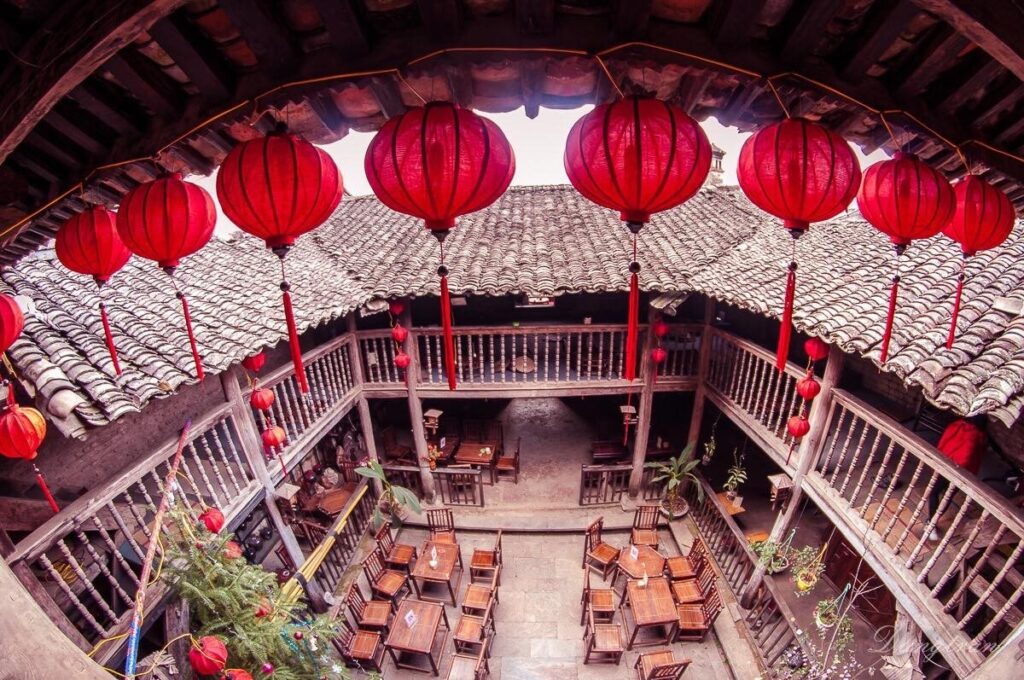In the remote reaches of northern Vietnam lies a hidden gem that whispers tales of the past with every cobblestone underfoot and every weathered facade that graces its winding lanes. Welcome to Dong Van Ancient Street, a place where history comes alive, inviting travellers to step back in time and immerse themselves in the cultural tapestry of centuries gone by.
History of Dong Van Ancient Street
 At a lofty 1,000-1,600m elevation, this ancient town is surrounded by rugged, forest-blanketed mountains on all sides. And if you visit in winter, be prepared for a crisp chill that’ll have you snuggling up in all your layers!Back in the early 20th century, this little quarter was just a home for a few Tay, Mong, and Hoa families. But as the Nung and Dao ethnic groups migrated in over time, the vibe became more lively and vibrant.Despite Ha Giang’s development pushes in recent decades to boost tourism, Dong Van has thankfully retained its ancient, rustic charm in the most captivating way. The winding stone alleys, carved into the mountainside, will make you feel like you’ve stumbled upon a forgotten realm.
At a lofty 1,000-1,600m elevation, this ancient town is surrounded by rugged, forest-blanketed mountains on all sides. And if you visit in winter, be prepared for a crisp chill that’ll have you snuggling up in all your layers!Back in the early 20th century, this little quarter was just a home for a few Tay, Mong, and Hoa families. But as the Nung and Dao ethnic groups migrated in over time, the vibe became more lively and vibrant.Despite Ha Giang’s development pushes in recent decades to boost tourism, Dong Van has thankfully retained its ancient, rustic charm in the most captivating way. The winding stone alleys, carved into the mountainside, will make you feel like you’ve stumbled upon a forgotten realm. Architectural Marvels

One of the defining features of this ancient street is its architectural heritage. Here, traditional Hmong and Tay legacy mingle with French colonial buildings, creating a captivating blend of styles that is both eclectic and harmonious. Wandering through the narrow alleyways, visitors are treated to a visual feast of intricately carved wooden balconies, and ancient stone houses.
Cultural Heritage
 But Dong Van Ancient Street is more than just a collection of old buildings; it is a living testament to the rich cultural heritage of the region. Here, traditional crafts and trades continue to thrive, passed down through generations. Visitors can witness artisans at work, weaving intricate textiles and crafting pottery. Festivals and events throughout the year offer a glimpse into the vibrant traditions and customs of the area, from colorful processions to lively market days.
But Dong Van Ancient Street is more than just a collection of old buildings; it is a living testament to the rich cultural heritage of the region. Here, traditional crafts and trades continue to thrive, passed down through generations. Visitors can witness artisans at work, weaving intricate textiles and crafting pottery. Festivals and events throughout the year offer a glimpse into the vibrant traditions and customs of the area, from colorful processions to lively market days. Exploring Dong Van Ancient Street
 Exploring Dong Van Ancient Street is a journey of discovery, with surprises waiting around every corner. From ancient temples and pagodas to bustling markets and quaint tea houses, there is no shortage of attractions to captivate the curious traveller. Whether strolling leisurely along the cobblestone streets or delving into the hidden alleys, every step reveals a new facet of this enchanting destination. Visitors can immerse themselves in the hustle and bustle of daily life, striking up conversations with friendly locals and sampling delicious street food along the way.
Exploring Dong Van Ancient Street is a journey of discovery, with surprises waiting around every corner. From ancient temples and pagodas to bustling markets and quaint tea houses, there is no shortage of attractions to captivate the curious traveller. Whether strolling leisurely along the cobblestone streets or delving into the hidden alleys, every step reveals a new facet of this enchanting destination. Visitors can immerse themselves in the hustle and bustle of daily life, striking up conversations with friendly locals and sampling delicious street food along the way. What to eat in Dong Van
 If you find yourself wandering the ancient streets of Dong Van in Ha Giang province, you’re in for a real treat! The street food stalls here are a treasure trove of regional specialties. We’re talking all the iconic Ha Giang goodies to snack on or bring home as edible souvenirs for your loved ones.But here’s the real insider tip – time your visit for weekends or festivals if you can. That’s when the real stars come out to play! I’m talking must-try delicacies like silky banh cuon (steamed rice rolls), hearty buffalo stew simmered overnight, and the showstopper – ngũ sắc xôi, a kaleidoscope of sticky rice colors that’s almost too pretty to eat. Almost.The flavors here are just totally unique, from the grassy notes of Bac Me rice to the chewy of thit trau gac bep (dried buffalo meat). Even humble dish like au tau porridge is famous for its fresh local ingredients.
If you find yourself wandering the ancient streets of Dong Van in Ha Giang province, you’re in for a real treat! The street food stalls here are a treasure trove of regional specialties. We’re talking all the iconic Ha Giang goodies to snack on or bring home as edible souvenirs for your loved ones.But here’s the real insider tip – time your visit for weekends or festivals if you can. That’s when the real stars come out to play! I’m talking must-try delicacies like silky banh cuon (steamed rice rolls), hearty buffalo stew simmered overnight, and the showstopper – ngũ sắc xôi, a kaleidoscope of sticky rice colors that’s almost too pretty to eat. Almost.The flavors here are just totally unique, from the grassy notes of Bac Me rice to the chewy of thit trau gac bep (dried buffalo meat). Even humble dish like au tau porridge is famous for its fresh local ingredients. 